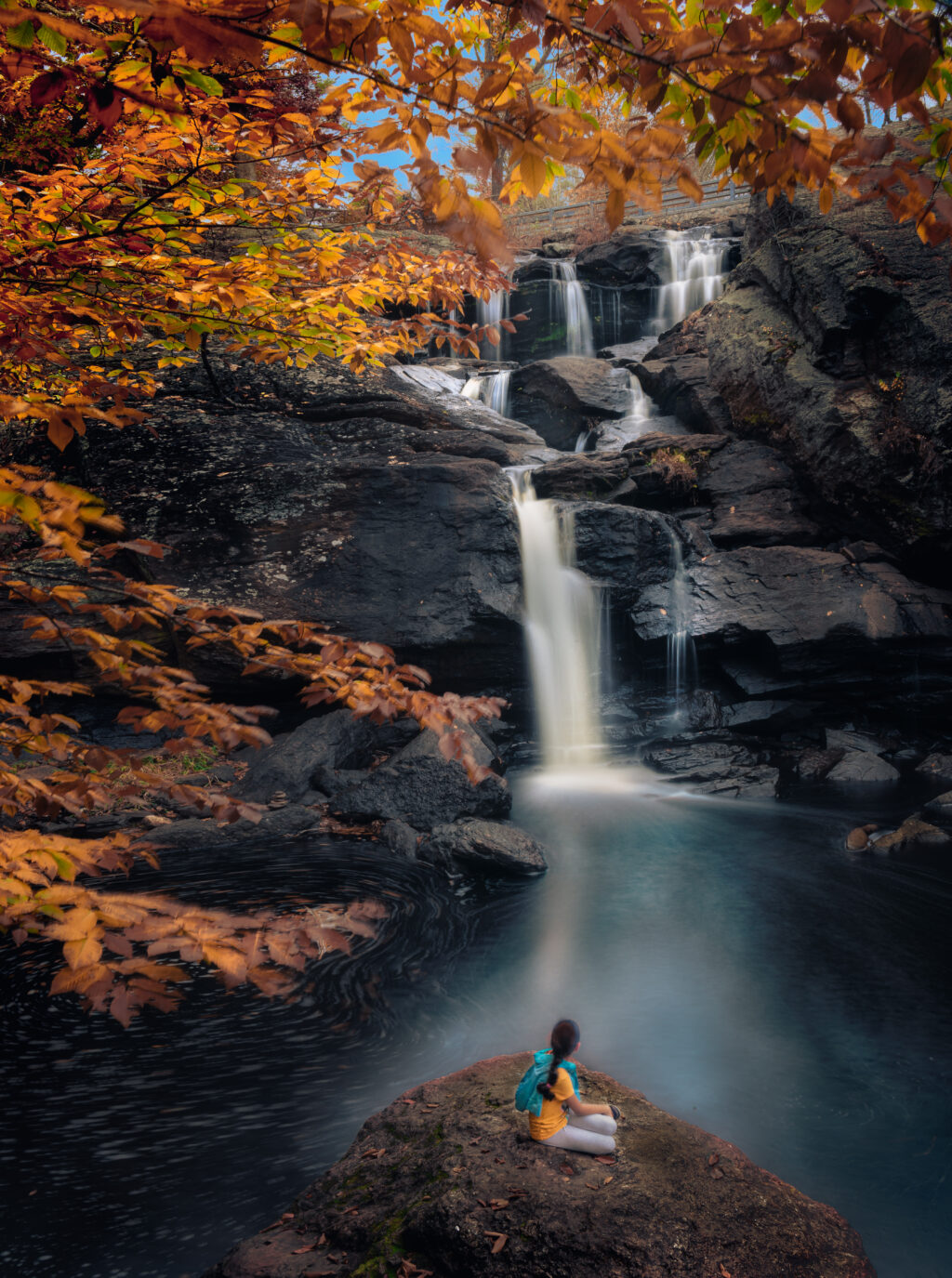Photographer Steve Silk Captures the Magical Beauty of the State’s Water Wonders
By FRANK RIZZO
Enter Connecticut’s waterfall wonderland and let your dreams take over. Take in the blurring cascades, the glistening moss, the summer leaves dotting the waters, the hypnotic swirls of an eddy and a stunning sunburst behind the towering trees, blessing it all. This is the surreal landscape that Steve Silk creates through the lens of his camera and his skills as an artist.
“I came to Connecticut’s waterfalls sort of through the back way,” said Silk, who has covered the state as a photographer, writer and magazine editor for more than 45 years.
“I became enamored in photographing these big, epic, powerful natural wonders around the world,” he continued. “But when the pandemic hit and I was stuck in my back yard in Farmington, I thought, ‘Well, what can I do around here? What are the great extreme natural forces around Connecticut that give you that sense of awe?’.”
Silk heard about the series of waterfalls at Enders State Forest in West Granby; one day during the pandemic he stopped by the state park of more than 2,100 acres, just off Route 20.
“I was just flabbergasted by all these different types of waterfalls there,” he exclaimed. He took out his camera and began shooting.
“One of the great things about waterfalls,” he said while recently hiking through the park with a backpack full of equipment, “is that they are different every day: their flows, sounds, surroundings—always different in every way.”
Despite the often turbulent dynamic of the waters, Silk said being in this setting—and the photographing of this natural surroundings where he was often the only person around— “almost became this meditative act when I went early morning or late afternoon when then light is best.”
It became another world: soothing, surreal, wondrous and emotionally moving.
“There’s a saying in photography—and it’s attributed to different people—but the saying is: ‘Don’t photograph what you see. Photograph what you feel.’ That’s what I’m trying to do. I’d like the viewer to feel some of the awe that I feel. I’m not there trying to document or make a realistic picture. I am there to capture an image that conveys how it feel about what I see, this sense of dreaminess—and even of peace, even though there’s a lot of turbulence conveyed, too.”
That practice of capturing the emotional connection with the photographer goes counter to what he learned at the School of Journalism at the University of Missouri and his work as an award-winning photojournalist and travel writer for such periodicals as The New Haven Journal-Courier, The Hartford Courant, The Stamford Advocate and the Litchfield County-based Fine Gardening magazine, where he was its managing editor.
“It was difficult for me at first to go from photojournalism where you don’t manipulate the image to working where you are totally controlling it,” he explained.
Silk’s images are not just lucky shots capturing a moment in time but rather ones that are carefully crafted, artistically shaped and thoughtfully constructed.
“I like to use the word ‘blended,’ bringing moments of time together where different elements are merged together,” he said. “I want to make it dreamy, maybe a little mysterious but intentionally not real.”
For the waterfalls especially, Silk aims to reflect that water energy in an interesting way.
“I use a slow shutter speed because ordinarily in photography you’re trying to capture a minute slice of time, but with a longer shutter speed, you’re blurring the water, your transcending being locked into a single second, and you’re extending time itself.”
And what is Silk looking for when he puts the lens to his eye?
“The flow of the water,” he articulated. “But I don’t just want to have the falls itself. I want an interesting foreground, perhaps a little rapid near the base of the falls, or an interesting rock formation, or an interesting eddy where floating objects would swirl around and make for an interesting time exposure.”
Other elements include what he calls “sun stars,” when the sun is partially obscured by a tree or rock or any solid object, giving it a radiant aura.
Silk said he is not intentionally seeking animal life in his compositions like deer or beavers, but if a bird might suddenly fly by or he discovers a crane in the water, it can add an unexpected element to the composition.
Silk stated the waterfalls are the best examples in Connecticut of the natural “awe-scapes” he searches for as he travels around the globe in places like Iceland, Namibia, Newfoundland and South America, among other dramatic locales. What he’s learned from spending time with the state’s waterfalls and his practice of blending images will now be part of his skillset and processing techniques when he travels abroad later this year—especially to Iceland, which is full of waterfalls that conjure the stuff of dreams.
“That dreaminess is an element I’m trying to make as a hallmark,” he said.
Silk’s primary interest continues to lie in photographing extreme settings around the world; beyond the waterfalls, Connecticut doesn’t have that kind of geography. However, photographing the state’s coastline via drone does intrigue him.
“The patterns of the salt marshes from above I think would be interesting,” he explained, “and I’d love to shoot Branford’s Thimble Islands from above, from a new perspective.”
But, for now, he’s off to far-flung, jaw-dropping locales. But when he is home again, he will surely be returning again and again to these nearby falling waters—and those he recreates—that keep calling to him, as if in a dream.
Frank Rizzo is a freelance journalist who writes for Variety, The New York Times, American Theatre, Connecticut Magazine, and other periodicals and outlets, including ShowRiz.com. He lives in New Haven and New York City. Follow Frank at ShowRiz@Twitter.






More Stories
Happy Senior Hour for the Holidays
At Home With Kerri-Lee
A New, Free Peabody Museum Prepares for Opening